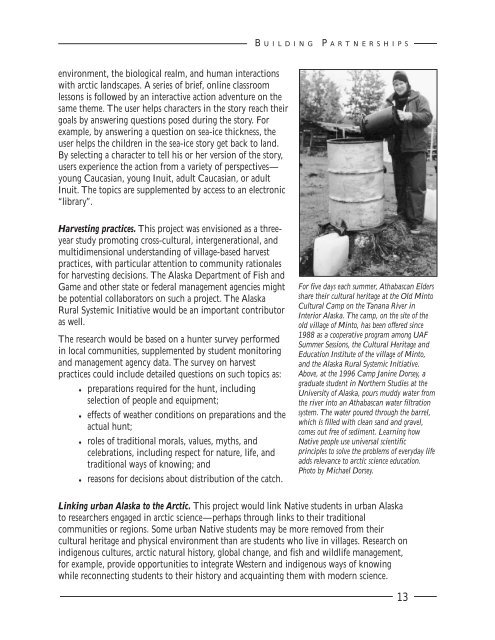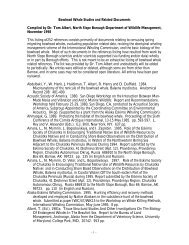ed report 4 page cover - Arctic Research Consortium of the United ...
ed report 4 page cover - Arctic Research Consortium of the United ...
ed report 4 page cover - Arctic Research Consortium of the United ...
You also want an ePaper? Increase the reach of your titles
YUMPU automatically turns print PDFs into web optimized ePapers that Google loves.
environment, <strong>the</strong> biological realm, and human interactions<br />
with arctic landscapes. A series <strong>of</strong> brief, online classroom<br />
lessons is follow<strong>ed</strong> by an interactive action adventure on <strong>the</strong><br />
same <strong>the</strong>me. The user helps characters in <strong>the</strong> story reach <strong>the</strong>ir<br />
goals by answering questions pos<strong>ed</strong> during <strong>the</strong> story. For<br />
example, by answering a question on sea-ice thickness, <strong>the</strong><br />
user helps <strong>the</strong> children in <strong>the</strong> sea-ice story get back to land.<br />
By selecting a character to tell his or her version <strong>of</strong> <strong>the</strong> story,<br />
users experience <strong>the</strong> action from a variety <strong>of</strong> perspectives—<br />
young Caucasian, young Inuit, adult Caucasian, or adult<br />
Inuit. The topics are supplement<strong>ed</strong> by access to an electronic<br />
“library”.<br />
Harvesting practices. This project was envision<strong>ed</strong> as a threeyear<br />
study promoting cross-cultural, intergenerational, and<br />
multidimensional understanding <strong>of</strong> village-bas<strong>ed</strong> harvest<br />
practices, with particular attention to community rationales<br />
for harvesting decisions. The Alaska Department <strong>of</strong> Fish and<br />
Game and o<strong>the</strong>r state or f<strong>ed</strong>eral management agencies might<br />
be potential collaborators on such a project. The Alaska<br />
Rural Systemic Initiative would be an important contributor<br />
as well.<br />
The research would be bas<strong>ed</strong> on a hunter survey perform<strong>ed</strong><br />
in local communities, supplement<strong>ed</strong> by student monitoring<br />
and management agency data. The survey on harvest<br />
practices could include detail<strong>ed</strong> questions on such topics as:<br />
♦ preparations requir<strong>ed</strong> for <strong>the</strong> hunt, including<br />
selection <strong>of</strong> people and equipment;<br />
♦ effects <strong>of</strong> wea<strong>the</strong>r conditions on preparations and <strong>the</strong><br />
actual hunt;<br />
♦ roles <strong>of</strong> traditional morals, values, myths, and<br />
celebrations, including respect for nature, life, and<br />
traditional ways <strong>of</strong> knowing; and<br />
♦ reasons for decisions about distribution <strong>of</strong> <strong>the</strong> catch.<br />
B U I L D I N G P A R T N E R S H I P S<br />
For five days each summer, Athabascan Elders<br />
share <strong>the</strong>ir cultural heritage at <strong>the</strong> Old Minto<br />
Cultural Camp on <strong>the</strong> Tanana River in<br />
Interior Alaska. The camp, on <strong>the</strong> site <strong>of</strong> <strong>the</strong><br />
old village <strong>of</strong> Minto, has been <strong>of</strong>fer<strong>ed</strong> since<br />
1988 as a cooperative program among UAF<br />
Summer Sessions, <strong>the</strong> Cultural Heritage and<br />
Education Institute <strong>of</strong> <strong>the</strong> village <strong>of</strong> Minto,<br />
and <strong>the</strong> Alaska Rural Systemic Initiative.<br />
Above, at <strong>the</strong> 1996 Camp Janine Dorsey, a<br />
graduate student in Nor<strong>the</strong>rn Studies at <strong>the</strong><br />
University <strong>of</strong> Alaska, pours muddy water from<br />
<strong>the</strong> river into an Athabascan water filtration<br />
system. The water pour<strong>ed</strong> through <strong>the</strong> barrel,<br />
which is fill<strong>ed</strong> with clean sand and gravel,<br />
comes out free <strong>of</strong> s<strong>ed</strong>iment. Learning how<br />
Native people use universal scientific<br />
principles to solve <strong>the</strong> problems <strong>of</strong> everyday life<br />
adds relevance to arctic science <strong>ed</strong>ucation.<br />
Photo by Michael Dorsey.<br />
Linking urban Alaska to <strong>the</strong> <strong>Arctic</strong>. This project would link Native students in urban Alaska<br />
to researchers engag<strong>ed</strong> in arctic science—perhaps through links to <strong>the</strong>ir traditional<br />
communities or regions. Some urban Native students may be more remov<strong>ed</strong> from <strong>the</strong>ir<br />
cultural heritage and physical environment than are students who live in villages. <strong>Research</strong> on<br />
indigenous cultures, arctic natural history, global change, and fish and wildlife management,<br />
for example, provide opportunities to integrate Western and indigenous ways <strong>of</strong> knowing<br />
while reconnecting students to <strong>the</strong>ir history and acquainting <strong>the</strong>m with modern science.<br />
13




